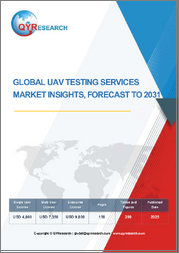
|
시장보고서
상품코드
1577691
세계의 NDT 자동화 필름 프로세서 시장 : 프로세서 유형, 필름 사이즈, 최종사용자 산업, 기술, 동작 모드, 필름 유형, 용도별 예측(2025-2030년)NDT Automatic Film Processor Market by Processor Type, Film Size, End-User Industry, Technology, Mode of Operation, Film Type, Application - Global Forecast 2025-2030 |
||||||
NDT 자동화 필름 프로세서 시장의 2023년 시장 규모는 89억 3,000만 달러, 2024년에는 93억 9,000만 달러에 이를 것으로 예측되며, 복합 연간 성장률(CAGR) 5.43%로 성장하여 2030년에는 129억 3,000만 달러에 달할 것으로 예상됩니다.
NDT(비파괴 검사) 자동화 필름 프로세서 시장은 다양한 산업 분야에서 사용되는 엑스레이 사진 필름의 처리를 자동화하는 기술을 포함하는 광범위한 시장입니다. 이러한 프로세서는 우주 항공, 자동차, 석유 및 가스, 건설 등 원래 자산을 손상시키지 않고 구조적 결함을 정확하게 감지하는 것이 가장 중요한 분야에서 필수적입니다. NDT 자동화 필름 프로세서의 필요성은 효율성, 수작업으로 인한 실수 감소, 안전 기준 향상에 대한 업계의 요구에 따라 증가하고 있습니다. 최종 용도는 품질 관리, 유지보수 검사, 컴플라이언스 준수에 널리 사용되며, 주로 견고한 안전 프로토콜과 신뢰할 수 있는 인프라가 필요한 산업에서 사용됩니다.
| 주요 시장 통계 | |
|---|---|
| 기준년(2023) | 89억 3,000만 달러 |
| 예측년(2024) | 93억 9,000만 달러 |
| 예측년(2030) | 129억 3,000만 달러 |
| 복합 연간 성장률(CAGR)(%) | 5.43% |
주요 성장 요인으로는 정밀하고 신속한 검사 솔루션에 대한 수요 증가, 자동화 기술의 발전, 세계적으로 엄격한 안전 규제 등이 있습니다. 기술 중심의 산업용도 및 스마트 제조 공정 등 디지털화 및 자동화를 중시하는 분야에서는 잠재적인 비즈니스 기회가 탄생했습니다. 이러한 기회를 활용하기 위해 기업은 실시간 데이터 처리 및 관리 시스템과의 연결과 같은 첨단 기능의 통합에 주력해야 하므로 효율성을 크게 높일 수 있습니다.
그러나 설비 비용의 높이, 숙련된 오퍼레이터의 필요성, 엄격한 규제 준수 등의 제약이 시장 성장의 과제가 될 가능성이 있습니다. 또한, 종래의 필름 처리에서 디지털 X선 촬영으로의 전환이 진행되고 있는 것도 수요 동태에 불리한 영향을 미칠 수 있습니다.
기술 혁신과 연구에 관해서는 자동화 기술의 개선, 검사 프로세스의 디지털화의 강화, 필름 처리용의 환경 친화적인 화학 솔루션의 개발 등의 분야가 유망한 수단이 됩니다. 기업은 지속가능한 관행으로의 산업 변화가 진행되고 있는 가운데, 확장 가능하고 모듈화된 솔루션에 주력함으로써 이익을 얻을 수 있습니다. 이 시장에는 기존 기업와 혁신적인 신흥 기업이 섞여 있기 때문에 전략적 제휴와 인수를 통해 능력과 시장 범위를 확대할 수 있습니다. 이러한 역학을 이해하고 사용자 정의 가능한 솔루션과 에너지 효율적인 운영에 집중함으로써 이러한 진화 상황에서 비즈니스를 유리하게 구축할 수 있습니다.
시장 역학: 빠르게 진화하는 NDT 자동화 필름 프로세서 시장의 주요 시장 인사이트 공개
NDT 자동화 필름 프로세서 시장은 수요 및 공급의 역동적인 상호작용에 의해 변모를 이루고 있습니다. 이러한 시장 역학의 진화를 이해함으로써 기업은 충분한 정보를 바탕으로 투자결정, 전략적 결정 정밀화, 새로운 비즈니스 기회 획득에 대비할 수 있습니다. 이러한 동향을 종합적으로 파악함으로써 기업은 정치적, 지리적, 기술적, 사회적, 경제적 영역에 걸친 다양한 위험을 완화할 수 있으며, 소비자 행동과 그것이 제조 비용과 구매 동향에 미치는 영향을보다 명확하게 이해할 수 있습니다.
- 시장 성장 촉진요인
- 항공우주 및 방위 분야에서의 자동화 필름 가공기의 채용 증가
- 석유 및 가스 탐사, 생산 활동에 대한 대액 투자
- 자동차 제조의 확대와 정밀한 품질 관리의 필요성
- 엄격한 비파괴 검사를 필요로 하는 인프라 개발 프로젝트 증가
- 시장 성장 억제요인
- 고급 비파괴 검사용 자동화 필름 프로세서가 고비용이기 때문에 시장 성장이 제한됩니다.
- NDT 자동화 필름 프로세서 운영에 숙련된 전문가가 제한되어 시장 확대가 제한됩니다.
- 시장 기회
- NDT 서비스 제공업체들 사이에서 기술적으로 첨단적인 자동화 필름 프로세서의 채용이 증가
- 비파괴 검사 응용 분야에서 효율적이고 신뢰할 수 있는 필름 처리 솔루션에 대한 수요 증가
- 다양한 산업에서 품질관리와 안전성이 중시되어 자동 NDT 필름 프로세서의 요구가 높아지고 있습니다.
- 시장의 과제
- NDT 자동화 필름 프로세서 시장의 성장을 방해하는 경제적, 규제적 장애물
- 기술 진보와 NDT 자동화 필름 프로세서 시장 역학에 미치는 영향
Porter's Five Forces : NDT 자동화 필름 프로세서 시장을 탐색하는 전략 도구
Porter's Five Forces Framework는 NDT 자동화 필름 프로세서 시장 경쟁 구도를 이해하는 중요한 도구입니다. Porter's Five Forces Framework는 기업의 경쟁력을 평가하고 전략적 기회를 탐구하는 명확한 기술을 제공합니다. 이 프레임워크는 기업이 시장 내 세력도를 평가하고 신규 사업의 수익성을 결정하는 데 도움이 됩니다. 이러한 통찰을 통해 기업은 자사의 강점을 활용하고, 약점을 해결하고, 잠재적인 과제를 피할 수 있으며, 보다 강인한 시장에서의 포지셔닝을 보장할 수 있습니다.
PESTLE 분석 : NDT 자동화 필름 프로세서 시장에서 외부 영향을 파악
외부 거시적 환경 요인은 NDT 자동화 필름 프로세서 시장의 성과 역학을 형성하는데 매우 중요한 역할을 합니다. 정치적, 경제적, 사회적, 기술적, 법적, 환경적 요인 분석은 이러한 영향을 탐색하는 데 필요한 정보를 제공합니다. PESTLE 요인을 조사함으로써 기업은 잠재적인 위험과 기회를 더 잘 이해할 수 있습니다. 이 분석을 통해 기업은 규제, 소비자 선호, 경제 동향의 변화를 예측하고 앞으로 예상되는 적극적인 의사 결정을 할 준비를 할 수 있습니다.
시장 점유율 분석 NDT 자동화 필름 프로세서 시장에서 경쟁 구도 파악
NDT 자동화 필름 프로세서 시장의 상세한 시장 점유율 분석을 통해 공급업체의 성과를 종합적으로 평가할 수 있습니다. 기업은 수익, 고객 기반, 성장률 등 주요 지표를 비교하여 경쟁 포지셔닝을 밝힐 수 있습니다. 이 분석을 통해 시장 집중, 단편화, 통합 동향을 밝혀내고 공급업체는 경쟁이 치열해지면서 자사의 지위를 높이는 전략적 의사 결정을 내리는 데 필요한 지식을 얻을 수 있습니다.
FPNV 포지셔닝 매트릭스 NDT 자동화 필름 프로세서 시장에서 공급업체의 성능 평가
FPNV 포지셔닝 매트릭스는 NDT 자동화 필름 프로세서 시장에서 벤더를 평가하는 중요한 도구입니다. 정보를 기반으로 의사 결정을 내릴 수 있습니다. 네 가지 사분면을 통해 벤더를 명확하고 정확하게 분류하고 전략 목표에 가장 적합한 파트너 및 솔루션을 파악할 수 있습니다.
전략 분석 및 권장 NDT 자동화 필름 프로세서 시장에서 성공을 위한 길을 그리기
NDT 자동화 필름 프로세서 시장의 전략 분석은 시장에서의 프레즌스 강화를 목표로 하는 기업에 필수적인 요소입니다. 이 방법을 사용하면 경쟁 구도에서 어려움을 극복하고 새로운 비즈니스 기회를 활용하여 장기적인 성공을 거둘 수 있습니다.
이 보고서는 주요 관심 분야를 포괄하는 시장의 종합적인 분석을 제공합니다.
1. 시장 침투 : 현재 시장 환경의 상세한 검토, 주요 기업의 광범위한 데이터, 시장 도달범위 및 전반적인 영향력 평가.
2. 시장 개척도 : 신흥 시장의 성장 기회를 파악하고 기존 분야의 확장 가능성을 평가하며 미래 성장을 위한 전략적 로드맵을 제공합니다.
3. 시장 다양화 : 최근 제품 출시, 미개척 지역, 업계의 주요 진보, 시장을 형성하는 전략적 투자를 분석합니다.
4. 경쟁 평가 및 정보 : 경쟁 구도를 철저히 분석하여 시장 점유율, 사업 전략, 제품 포트폴리오, 인증, 규제 당국 승인, 특허 동향, 주요 기업의 기술 진보 등을 검증합니다.
5. 제품 개발 및 혁신 : 미래 시장 성장을 가속할 것으로 예상되는 최첨단 기술, R&D 활동, 제품 혁신을 강조합니다.
또한 이해관계자가 충분한 정보를 얻고 의사결정을 할 수 있도록 중요한 질문에 대답하고 있습니다.
1. 현재 시장 규모와 향후 성장 예측은?
2. 최고의 투자 기회를 제공하는 제품, 부문 및 지역은 어디입니까?
3. 시장을 형성하는 주요 기술 동향과 규제의 영향은?
4. 주요 벤더의 시장 점유율과 경쟁 포지션은?
5. 벤더 시장 진입, 철수 전략의 원동력이 되는 수익원과 전략적 기회는 무엇인가?
목차
제1장 서문
제2장 조사 방법
제3장 주요 요약
제4장 시장 개요
제5장 시장 인사이트
- 시장 역학
- 성장 촉진요인
- 항공우주 및 방위 분야에서의 자동화 필름 프로세서의 채용 증가
- 석유 및 가스의 탐사, 생산 활동에의 다액의 투자
- 자동차 제조업의 확대와 정밀한 품질 관리의 필요성
- 엄격한 비파괴 검사를 필요로 하는 인프라 개발 프로젝트 증가
- 억제요인
- 고도의 비파괴 검사 자동화 필름 처리 장치의 고비용이 시장 성장을 제한하고 있다
- NDT 자동화 필름 프로세서를 조작하는 숙련된 전문가의 부족으로 시장 확대가 제한되고 있다
- 기회
- NDT 서비스 제공업체들 사이에서 기술적으로 고도의 자동화 필름 프로세서 채용이 증가
- 비파괴 검사 응용 분야에서 효율적이고 신뢰할 수 있는 필름 처리 솔루션 수요 증가
- 다양한 산업에서 품질관리와 안전성을 중시하게 되어 자동 비파괴 검사 필름 처리장치의 필요성이 높아지고 있습니다.
- 과제
- 경제와 규제 장애물이 성장을 방해하는 NDT 자동화 필름 프로세서 시장
- 기술의 진보와 NDT 자동화 필름 프로세서 시장 동향에 대한 영향
- 성장 촉진요인
- 시장 세분화 분석
- Porter's Five Forces 분석
- PESTEL 분석
- 정치적
- 경제
- 사교
- 기술적
- 법률상
- 환경
제6장 NDT 자동화 필름 프로세서 시장 : 프로세서 유형별
- 인라인 프로세서
- 독립형 프로세서
- 탁상용 프로세서
제7장 NDT 자동화 필름 프로세서 시장 : 필름 크기별
- 10인치
- 12인치
- 16인치
제8장 NDT 자동화 필름 프로세서 시장 : 최종 사용자 업계별
- 공사
- 헬스케어
- 치과 진료소
- 진단센터
- 병원
- 제조업
- 항공우주
- 자동차
- 일렉트로닉스
- 석유 및 가스
- 분포
- 탐험
- 정제
제9장 NDT 자동화 필름 프로세서 시장 : 기술별
- 레이저
- 자성 입자
- 엑스레이
- 초음파
제10장 NDT 자동화 필름 프로세서 시장 : 운영 모드별
- 자동화
- 매뉴얼
- 반자동
제11장 NDT 자동화 필름 프로세서 시장 : 영화 유형별
- 아그파 필름
- 인더스트렉스 필름
- 표준 X선 필름
- 스트럭처릭스 필름
제12장 NDT 자동화 필름 프로세서 시장 : 용도별
- 결함 검출
- 치수 측정
- 재료 분석
- 품질관리
제13장 아메리카의 NDT 자동화 필름 프로세서 시장
- 아르헨티나
- 브라질
- 캐나다
- 멕시코
- 미국
제14장 아시아태평양의 NDT 자동화 필름 프로세서 시장
- 호주
- 중국
- 인도
- 인도네시아
- 일본
- 말레이시아
- 필리핀
- 싱가포르
- 한국
- 대만
- 태국
- 베트남
제15장 유럽, 중동 및 아프리카의 NDT 자동화 필름 프로세서 시장
- 덴마크
- 이집트
- 핀란드
- 프랑스
- 독일
- 이스라엘
- 이탈리아
- 네덜란드
- 나이지리아
- 노르웨이
- 폴란드
- 카타르
- 러시아
- 사우디아라비아
- 남아프리카
- 스페인
- 스웨덴
- 스위스
- 터키
- 아랍에미리트(UAE)
- 영국
제16장 경쟁 구도
- 시장 점유율 분석(2023년)
- FPNV 포지셔닝 매트릭스(2023년)
- 경쟁 시나리오 분석
- 전략 분석과 제안
The NDT Automatic Film Processor Market was valued at USD 8.93 billion in 2023, expected to reach USD 9.39 billion in 2024, and is projected to grow at a CAGR of 5.43%, to USD 12.93 billion by 2030.
The NDT (Non-Destructive Testing) Automatic Film Processor market is expansive, encompassing technologies that automate the processing of radiographic films used in various industrial applications. These processors are integral in sectors like aerospace, automotive, oil & gas, and construction, where precision in detecting structural flaws without damaging the original asset is paramount. The necessity of NDT automatic film processors is elevated by the industry's need for efficiency, reduced manual errors, and improved safety standards. Applications are widespread in quality control, maintenance inspections, and compliance adherence, with end-use markets being primarily industries that require robust safety protocols and reliable infrastructure.
| KEY MARKET STATISTICS | |
|---|---|
| Base Year [2023] | USD 8.93 billion |
| Estimated Year [2024] | USD 9.39 billion |
| Forecast Year [2030] | USD 12.93 billion |
| CAGR (%) | 5.43% |
Key growth influencers include the increasing demand for precise and rapid testing solutions, technological advancements in automation, and stringent safety regulations worldwide. Potential opportunities are emerging in sectors emphasizing digitization and automation, such as tech-driven industrial applications and smart manufacturing processes. To harness these opportunities, companies should focus on integrating advanced features like real-time data processing and connectivity with management systems, which can significantly enhance efficiency.
However, limitations such as high equipment costs, the necessity for skilled operators, and stringent regulatory compliance can pose challenges to market growth. Moreover, the ongoing transition from traditional film processing to digital radiography could also affect the demand dynamics unfavorably.
For innovation and research, areas such as improving automation technologies, enhancing the digitalization of testing processes, and developing eco-friendly chemical solutions for film processing present promising avenues. Businesses can benefit from focusing on scalable and modular solutions that align with the growing industry shift toward sustainable practices. The market's nature, marked by a mix of established players and innovative start-ups, suggests potential for strategic alliances or acquisitions to expand capabilities and market reach. Understanding these dynamics and focusing on customizable solutions and energy-efficient operations can position businesses favorably in this evolving landscape.
Market Dynamics: Unveiling Key Market Insights in the Rapidly Evolving NDT Automatic Film Processor Market
The NDT Automatic Film Processor Market is undergoing transformative changes driven by a dynamic interplay of supply and demand factors. Understanding these evolving market dynamics prepares business organizations to make informed investment decisions, refine strategic decisions, and seize new opportunities. By gaining a comprehensive view of these trends, business organizations can mitigate various risks across political, geographic, technical, social, and economic domains while also gaining a clearer understanding of consumer behavior and its impact on manufacturing costs and purchasing trends.
- Market Drivers
- Rising adoption of automatic film processors in aerospace and defense sectors
- Significant investments in oil and gas exploration and production activities
- Expansion of automotive manufacturing and need for precise quality control
- Growing infrastructure development projects requiring rigorous non-destructive testing
- Market Restraints
- The high cost of advanced NDT automatic film processors limits market growth
- Limited availability of skilled professionals for operating NDT automatic film processors restricts market expansion
- Market Opportunities
- Increasing adoption of technologically advanced automatic film processors among NDT service providers
- Rising demand for efficient and reliable film processing solutions in non-destructive testing applications
- Growing emphasis on quality control and safety in various industries driving the need for automatic NDT film processors
- Market Challenges
- Economic and regulatory hurdles hindering the growth of the NDT automatic film processor market
- Technological advancements and their impact on the NDT automatic film processor market dynamics
Porter's Five Forces: A Strategic Tool for Navigating the NDT Automatic Film Processor Market
Porter's five forces framework is a critical tool for understanding the competitive landscape of the NDT Automatic Film Processor Market. It offers business organizations with a clear methodology for evaluating their competitive positioning and exploring strategic opportunities. This framework helps businesses assess the power dynamics within the market and determine the profitability of new ventures. With these insights, business organizations can leverage their strengths, address weaknesses, and avoid potential challenges, ensuring a more resilient market positioning.
PESTLE Analysis: Navigating External Influences in the NDT Automatic Film Processor Market
External macro-environmental factors play a pivotal role in shaping the performance dynamics of the NDT Automatic Film Processor Market. Political, Economic, Social, Technological, Legal, and Environmental factors analysis provides the necessary information to navigate these influences. By examining PESTLE factors, businesses can better understand potential risks and opportunities. This analysis enables business organizations to anticipate changes in regulations, consumer preferences, and economic trends, ensuring they are prepared to make proactive, forward-thinking decisions.
Market Share Analysis: Understanding the Competitive Landscape in the NDT Automatic Film Processor Market
A detailed market share analysis in the NDT Automatic Film Processor Market provides a comprehensive assessment of vendors' performance. Companies can identify their competitive positioning by comparing key metrics, including revenue, customer base, and growth rates. This analysis highlights market concentration, fragmentation, and trends in consolidation, offering vendors the insights required to make strategic decisions that enhance their position in an increasingly competitive landscape.
FPNV Positioning Matrix: Evaluating Vendors' Performance in the NDT Automatic Film Processor Market
The Forefront, Pathfinder, Niche, Vital (FPNV) Positioning Matrix is a critical tool for evaluating vendors within the NDT Automatic Film Processor Market. This matrix enables business organizations to make well-informed decisions that align with their goals by assessing vendors based on their business strategy and product satisfaction. The four quadrants provide a clear and precise segmentation of vendors, helping users identify the right partners and solutions that best fit their strategic objectives.
Strategy Analysis & Recommendation: Charting a Path to Success in the NDT Automatic Film Processor Market
A strategic analysis of the NDT Automatic Film Processor Market is essential for businesses looking to strengthen their global market presence. By reviewing key resources, capabilities, and performance indicators, business organizations can identify growth opportunities and work toward improvement. This approach helps businesses navigate challenges in the competitive landscape and ensures they are well-positioned to capitalize on newer opportunities and drive long-term success.
Key Company Profiles
The report delves into recent significant developments in the NDT Automatic Film Processor Market, highlighting leading vendors and their innovative profiles. These include Agfa-Gevaert N.V., Ashtead Technology Ltd., Carestream NDT, Duerr NDT, Fujifilm Holdings Corporation, GE Measurement and Control, Hitachi High-Tech Corporation, Insight Vision GmbH, Jeol Ltd., Konica Minolta, Nikon Metrology Inc., Olympus Corporation, Shimadzu Corporation, Sonatest Ltd., Teledyne DALSA, Thermo Fisher Scientific, Vidisco Ltd., Waygate Technologies, YXLON International GmbH, and Zetec Inc..
Market Segmentation & Coverage
This research report categorizes the NDT Automatic Film Processor Market to forecast the revenues and analyze trends in each of the following sub-markets:
- Based on Processor Type, market is studied across In-Line Processors, Stand-Alone Processors, and Tabletop Processors.
- Based on Film Size, market is studied across 10 inches, 12 inches, and 16 inches.
- Based on End-User Industry, market is studied across Construction, Healthcare, Manufacturing, and Oil & Gas. The Healthcare is further studied across Dental Clinics, Diagnostic Centers, and Hospitals. The Manufacturing is further studied across Aerospace, Automotive, and Electronics. The Oil & Gas is further studied across Distribution, Exploration, and Refining.
- Based on Technology, market is studied across Laser, Magnetic Particle, Radiographic, and Ultrasonic.
- Based on Mode of Operation, market is studied across Automated, Manual, and Semi-Automated.
- Based on Film Type, market is studied across Agfa Films, Industrex Films, Standard X-Ray Films, and Structurix Films.
- Based on Application, market is studied across Defect Detection, Dimensional Measurement, Material Analysis, and Quality Control.
- Based on Region, market is studied across Americas, Asia-Pacific, and Europe, Middle East & Africa. The Americas is further studied across Argentina, Brazil, Canada, Mexico, and United States. The United States is further studied across California, Florida, Illinois, New York, Ohio, Pennsylvania, and Texas. The Asia-Pacific is further studied across Australia, China, India, Indonesia, Japan, Malaysia, Philippines, Singapore, South Korea, Taiwan, Thailand, and Vietnam. The Europe, Middle East & Africa is further studied across Denmark, Egypt, Finland, France, Germany, Israel, Italy, Netherlands, Nigeria, Norway, Poland, Qatar, Russia, Saudi Arabia, South Africa, Spain, Sweden, Switzerland, Turkey, United Arab Emirates, and United Kingdom.
The report offers a comprehensive analysis of the market, covering key focus areas:
1. Market Penetration: A detailed review of the current market environment, including extensive data from top industry players, evaluating their market reach and overall influence.
2. Market Development: Identifies growth opportunities in emerging markets and assesses expansion potential in established sectors, providing a strategic roadmap for future growth.
3. Market Diversification: Analyzes recent product launches, untapped geographic regions, major industry advancements, and strategic investments reshaping the market.
4. Competitive Assessment & Intelligence: Provides a thorough analysis of the competitive landscape, examining market share, business strategies, product portfolios, certifications, regulatory approvals, patent trends, and technological advancements of key players.
5. Product Development & Innovation: Highlights cutting-edge technologies, R&D activities, and product innovations expected to drive future market growth.
The report also answers critical questions to aid stakeholders in making informed decisions:
1. What is the current market size, and what is the forecasted growth?
2. Which products, segments, and regions offer the best investment opportunities?
3. What are the key technology trends and regulatory influences shaping the market?
4. How do leading vendors rank in terms of market share and competitive positioning?
5. What revenue sources and strategic opportunities drive vendors' market entry or exit strategies?
Table of Contents
1. Preface
- 1.1. Objectives of the Study
- 1.2. Market Segmentation & Coverage
- 1.3. Years Considered for the Study
- 1.4. Currency & Pricing
- 1.5. Language
- 1.6. Stakeholders
2. Research Methodology
- 2.1. Define: Research Objective
- 2.2. Determine: Research Design
- 2.3. Prepare: Research Instrument
- 2.4. Collect: Data Source
- 2.5. Analyze: Data Interpretation
- 2.6. Formulate: Data Verification
- 2.7. Publish: Research Report
- 2.8. Repeat: Report Update
3. Executive Summary
4. Market Overview
5. Market Insights
- 5.1. Market Dynamics
- 5.1.1. Drivers
- 5.1.1.1. Rising adoption of automatic film processors in aerospace and defense sectors
- 5.1.1.2. Significant investments in oil and gas exploration and production activities
- 5.1.1.3. Expansion of automotive manufacturing and need for precise quality control
- 5.1.1.4. Growing infrastructure development projects requiring rigorous non-destructive testing
- 5.1.2. Restraints
- 5.1.2.1. The high cost of advanced NDT automatic film processors limits market growth
- 5.1.2.2. Limited availability of skilled professionals for operating NDT automatic film processors restricts market expansion
- 5.1.3. Opportunities
- 5.1.3.1. Increasing adoption of technologically advanced automatic film processors among NDT service providers
- 5.1.3.2. Rising demand for efficient and reliable film processing solutions in non-destructive testing applications
- 5.1.3.3. Growing emphasis on quality control and safety in various industries driving the need for automatic NDT film processors
- 5.1.4. Challenges
- 5.1.4.1. Economic and regulatory hurdles hindering the growth of the NDT automatic film processor market
- 5.1.4.2. Technological advancements and their impact on the NDT automatic film processor market dynamics
- 5.1.1. Drivers
- 5.2. Market Segmentation Analysis
- 5.3. Porter's Five Forces Analysis
- 5.3.1. Threat of New Entrants
- 5.3.2. Threat of Substitutes
- 5.3.3. Bargaining Power of Customers
- 5.3.4. Bargaining Power of Suppliers
- 5.3.5. Industry Rivalry
- 5.4. PESTLE Analysis
- 5.4.1. Political
- 5.4.2. Economic
- 5.4.3. Social
- 5.4.4. Technological
- 5.4.5. Legal
- 5.4.6. Environmental
6. NDT Automatic Film Processor Market, by Processor Type
- 6.1. Introduction
- 6.2. In-Line Processors
- 6.3. Stand-Alone Processors
- 6.4. Tabletop Processors
7. NDT Automatic Film Processor Market, by Film Size
- 7.1. Introduction
- 7.2. 10 inches
- 7.3. 12 inches
- 7.4. 16 inches
8. NDT Automatic Film Processor Market, by End-User Industry
- 8.1. Introduction
- 8.2. Construction
- 8.3. Healthcare
- 8.3.1. Dental Clinics
- 8.3.2. Diagnostic Centers
- 8.3.3. Hospitals
- 8.4. Manufacturing
- 8.4.1. Aerospace
- 8.4.2. Automotive
- 8.4.3. Electronics
- 8.5. Oil & Gas
- 8.5.1. Distribution
- 8.5.2. Exploration
- 8.5.3. Refining
9. NDT Automatic Film Processor Market, by Technology
- 9.1. Introduction
- 9.2. Laser
- 9.3. Magnetic Particle
- 9.4. Radiographic
- 9.5. Ultrasonic
10. NDT Automatic Film Processor Market, by Mode of Operation
- 10.1. Introduction
- 10.2. Automated
- 10.3. Manual
- 10.4. Semi-Automated
11. NDT Automatic Film Processor Market, by Film Type
- 11.1. Introduction
- 11.2. Agfa Films
- 11.3. Industrex Films
- 11.4. Standard X-Ray Films
- 11.5. Structurix Films
12. NDT Automatic Film Processor Market, by Application
- 12.1. Introduction
- 12.2. Defect Detection
- 12.3. Dimensional Measurement
- 12.4. Material Analysis
- 12.5. Quality Control
13. Americas NDT Automatic Film Processor Market
- 13.1. Introduction
- 13.2. Argentina
- 13.3. Brazil
- 13.4. Canada
- 13.5. Mexico
- 13.6. United States
14. Asia-Pacific NDT Automatic Film Processor Market
- 14.1. Introduction
- 14.2. Australia
- 14.3. China
- 14.4. India
- 14.5. Indonesia
- 14.6. Japan
- 14.7. Malaysia
- 14.8. Philippines
- 14.9. Singapore
- 14.10. South Korea
- 14.11. Taiwan
- 14.12. Thailand
- 14.13. Vietnam
15. Europe, Middle East & Africa NDT Automatic Film Processor Market
- 15.1. Introduction
- 15.2. Denmark
- 15.3. Egypt
- 15.4. Finland
- 15.5. France
- 15.6. Germany
- 15.7. Israel
- 15.8. Italy
- 15.9. Netherlands
- 15.10. Nigeria
- 15.11. Norway
- 15.12. Poland
- 15.13. Qatar
- 15.14. Russia
- 15.15. Saudi Arabia
- 15.16. South Africa
- 15.17. Spain
- 15.18. Sweden
- 15.19. Switzerland
- 15.20. Turkey
- 15.21. United Arab Emirates
- 15.22. United Kingdom
16. Competitive Landscape
- 16.1. Market Share Analysis, 2023
- 16.2. FPNV Positioning Matrix, 2023
- 16.3. Competitive Scenario Analysis
- 16.4. Strategy Analysis & Recommendation
Companies Mentioned
- 1. Agfa-Gevaert N.V.
- 2. Ashtead Technology Ltd.
- 3. Carestream NDT
- 4. Duerr NDT
- 5. Fujifilm Holdings Corporation
- 6. GE Measurement and Control
- 7. Hitachi High-Tech Corporation
- 8. Insight Vision GmbH
- 9. Jeol Ltd.
- 10. Konica Minolta
- 11. Nikon Metrology Inc.
- 12. Olympus Corporation
- 13. Shimadzu Corporation
- 14. Sonatest Ltd.
- 15. Teledyne DALSA
- 16. Thermo Fisher Scientific
- 17. Vidisco Ltd.
- 18. Waygate Technologies
- 19. YXLON International GmbH
- 20. Zetec Inc.



















